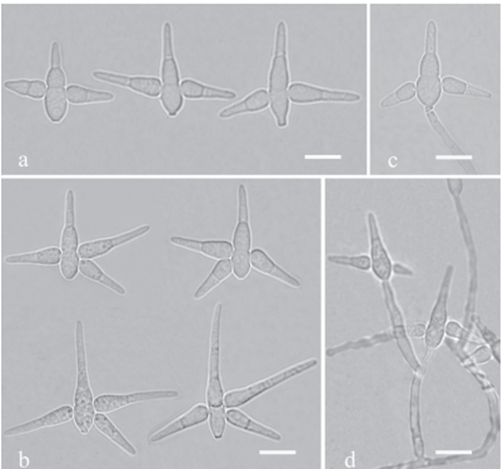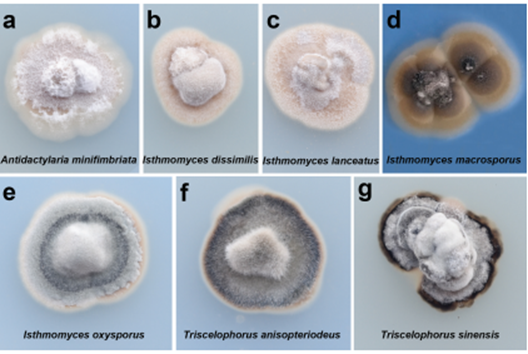 115
115
Triscelophorus sinensis Z. F. Yu, M. Qiao & R. F. Castañeda, sp. nov. 2021
Fungorum number: IF55852
Holotype YMF 1.04065
Morphological description :
Asexual morph: hyphomycetous. Colonies on CMA, attaining about 1 cm diam. after 20 days at 25 °C, pale mouse grey to dark mouse grey. Mycelium superficial and immersed, composed of branched, septate, hyaline hyphae. Conidiop macronematous, mononematous, lateral or terminal, cylindrical, erect, flexuous, separate, smooth, hyaline, up to 12–38 µm long, 1.0–2.4 µm wide. Conidiogenous cells monoblastic, cylindrical, terminal, integrated, determinate, smooth, hyaline. Conidia solitary, acrogenous, staurospore, septate, composed of a main axis and 2–3 lateral branches: i) the main axis obclavate, 2(–3)-septate, slightly constricted at the septa, straight, smooth, hyaline, 17.5–30.0 × 3.5–5.0 µm; ii) 2–3-lateral branches obclavate, (0–)1-septate, slightly constricted at the septa, straight, smooth, hyaline, 8.5–21.0 × 3.0–4.5 µm, arising from the basal cell of the main axis arranged in a regular or irregular verticillate.
Sexual state: unknown
Culture characteristics:
Habitat: on submerged leaves,
Distribution: China, Guangdong Province, Guangzhou,
GenBank: lsu MK577820 ; its MK569513.
Notes. In morphology, Triscelophorus sinensis is somewhat similar to T. ponapensis in conidia, both having 2–3 lateral arms (Matsushima 1981). However, T. ponapensis has shorter (main axis: 12–26 µm; lateral arms: 8–15 µm) and more septate (main axis: 2–4-septate; lateral arms: 1–4-septate) conidia.
Reference: [1] Qiao, M. , Zheng, H. , Guo, J. S. , Castaeda-Ruiz, R. F. , Xu, J. P. , & Peng, J. , et al. (2021). Two new asexual genera and six new asexual species in the family microthyriaceae (dothideomycetes, ascomycota) from china. MycoKeys, 85, 1-30. Triscelophorus sinensis (Holotype YMF 1.04065) a, b conidia c, d conidiophores with conidia. Scale bars: 10 µm (a–d).
Triscelophorus sinensis (Holotype YMF 1.04065) a, b conidia c, d conidiophores with conidia. Scale bars: 10 µm (a–d).

Cultural characters of all species in this study after 20 days on PDA at 25 °C

